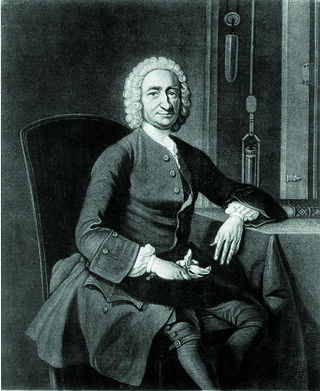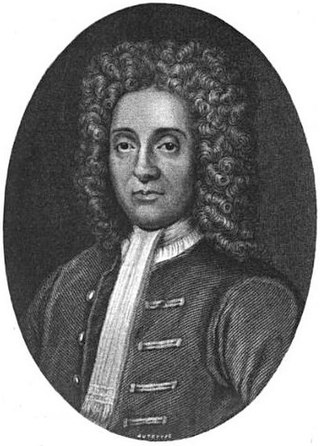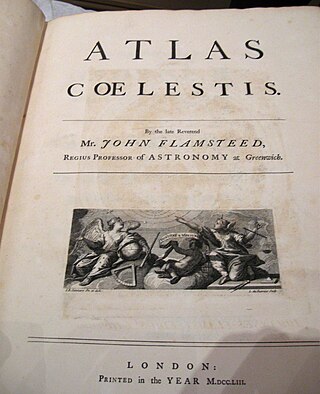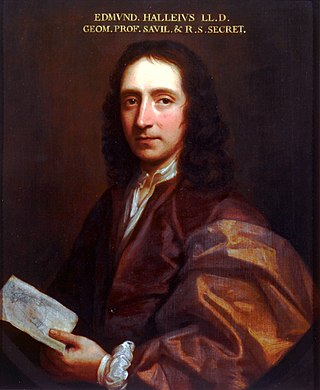Related Research Articles

Astronomer Royal is a senior post in the Royal Households of the United Kingdom. There are two officers, the senior being the astronomer royal dating from 22 June 1675; the junior is the astronomer royal for Scotland dating from 1834.

A Flamsteed designation is a combination of a number and constellation name that uniquely identifies most naked eye stars in the modern constellations visible from southern England. They are named for John Flamsteed who first used them while compiling his Historia Coelestis Britannica.

Johann Elert Bode was a German astronomer known for his reformulation and popularisation of the Titius–Bode law. Bode determined the orbit of Uranus and suggested the planet's name.

Abbé Nicolas-Louis de Lacaille, formerly sometimes spelled de la Caille, was a French astronomer and geodesist who named 14 out of the 88 constellations. From 1750 to 1754, he studied the sky at the Cape of Good Hope in present-day South Africa. Lacaille observed over 10,000 stars using a refracting telescope.

Frederick William Herschel was a German-British astronomer and composer. He frequently collaborated with his younger sister and fellow astronomer Caroline Herschel. Born in the Electorate of Hanover, William Herschel followed his father into the military band of Hanover, before emigrating to Great Britain in 1757 at the age of nineteen.

John Flamsteed was an English astronomer and the first Astronomer Royal. His main achievements were the preparation of a 3,000-star catalogue, Catalogus Britannicus, and a star atlas called Atlas Coelestis, both published posthumously. He also made the first recorded observations of Uranus, although he mistakenly catalogued it as a star, and he laid the foundation stone for the Royal Greenwich Observatory.

The Royal Observatory, Greenwich is an observatory situated on a hill in Greenwich Park in south east London, overlooking the River Thames to the north. It played a major role in the history of astronomy and navigation, and because the Prime Meridian passed through it, it gave its name to Greenwich Mean Time, the precursor to today's Coordinated Universal Time (UTC). The ROG has the IAU observatory code of 000, the first in the list. ROG, the National Maritime Museum, the Queen's House and the clipper ship Cutty Sark are collectively designated Royal Museums Greenwich.

Joseph Jérôme Lefrançois de Lalande was a French astronomer, freemason and writer.

Caroline Lucretia Herschel was a German-born British astronomer, whose most significant contributions to astronomy were the discoveries of several comets, including the periodic comet 35P/Herschel–Rigollet, which bears her name. She was the younger sister of astronomer William Herschel, with whom she worked throughout her career.
The year 1783 in science and technology involved some significant events:
The year 1675 in science and technology involved some significant events.

George Graham, FRS was an English clockmaker, inventor, and geophysicist, and a Fellow of the Royal Society.

Karl Ludwig Harding was a German astronomer, who discovered Juno, the third asteroid of the main-belt in 1804.

Johan August Hugo Gyldén was a Finland-Swedish astronomer primarily known for work in celestial mechanics.

Abraham Sharp was an English mathematician and astronomer.

The Atlas Coelestis is a star atlas published posthumously in 1729, based on observations made by the First Astronomer Royal, John Flamsteed.

EdmondHalley was an English astronomer, mathematician and physicist. He was the second Astronomer Royal in Britain, succeeding John Flamsteed in 1720.

James Hodgson (1672–1755) was an English astronomer, mathematical teacher, lecturer and writer.
Margaret Flamsteed is the first woman on record to be associated with astronomy in Britain. She was married to John Flamsteed, the Astronomical Observer. After John Flamsteed's death she oversaw publication of both of his most famous works: Historia Coelestis Britannica in 1725 and Atlas Coelestis in 1729. Without her, neither of these two important works would have been published.
References
- 1 2 3 4 5 Hockey, Thomas; Trimble, Virginia; Williams, Thomas R (2007). Biographical Encyclopedia of Astronomers. Springer. p. 263. ISBN 978-0-387-31022-0 . Retrieved 30 November 2018.
- ↑ Dolan, Graham. "People: Joseph Crosthwait". The Royal Observatory Greenwich. Retrieved 30 November 2018.
- ↑ Brück, Mary (2009). Women in Early British and Irish Astronomy: Stars and Satellites. Springer. p. 4. ISBN 978-90-481-2472-5.